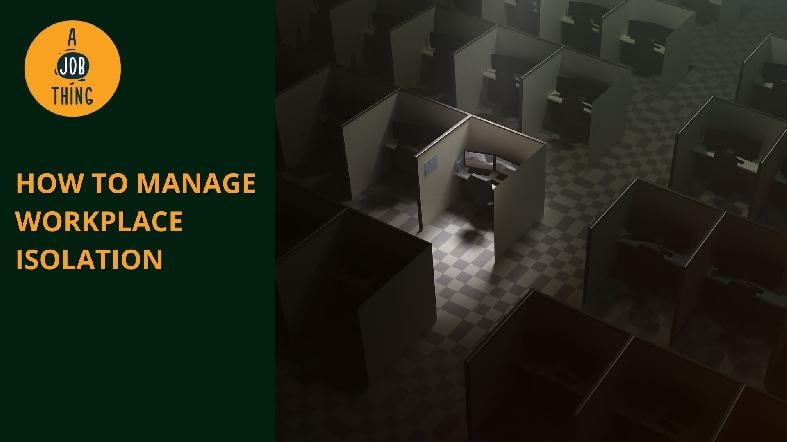
How to Manage Workplace Isolation
Are You Hiring?
Find candidates in 72 Hours with 5+ million talents in Maukerja Malaysia & Ricebowl using Job Ads.
Hire NowAccording to SHRM Research, approximately 28% of workers felt lonely or alone at work when a coworker left. What approach may employers use to reduce employee isolation at work?
Here are eight methods to help you decrease employee isolation in the workplace, regardless of their job or type of workspace, from practising purposeful thankfulness to reestablishing a sense of order.
1. Reframe virtual meetings
Require employees to use their webcams during virtual meetings to reduce employee isolation. To do so, reframe virtual meetings as "a window into each other's real lives" rather than "an alternative to in-person meetings." Once an employee has gained virtual comfort, they will find that they can become even more linked to their coworkers.
We may be thousands of miles apart, yet we are now closer to our coworkers' personal lives, including pets, children, collections, décor styles, and even the outfits they want to wear. Allowing employees to close the window will enable them to isolate themselves emotionally and physically.
2. Create a friendship-encouraging environment
According to Gallup, employee engagement and trust are increased when employees have strong friendships at work. It's why one of the 12 questions they use to gauge involvement is "I have a best buddy at work." Leaders may develop good workplace friendships by fostering and supporting team interactions.
Leaders can encourage (and even establish) workplace friendships by acting as role models for their employees. Leaders can also ensure that the physical workspace allows for the formation of informal relationships. Set up team trips, allow for casual interaction time (e.g., "coffee breaks"), and open up team meetings with a personal check-in to encourage employees to spend time together that isn't focused on the task itself.
3. Build an atmosphere of openness and trust
Fostering an atmosphere of trust and transparency is one method for businesses to decrease employee workplace isolation. Employees must be able to bring their actual honest selves to work since the culture is open. To create such an environment, people must be able to contribute, be heard, and be informed about what is going on.
Employee vulnerability must be encouraged by leaders, who must create opportunities for employees to build trust, connect, and cultivate connections both within and between teams. Icebreakers, introductions on meeting agendas, happy hours or tea/coffee hours, cross-functional team projects and workspaces, and employee resource groups are a few suggestions for making these connections.
Employees must be able to step beyond their comfort zones and share something about themselves with others to create trust through personal connections and relationship building.
4. Storytelling
Assume it's similar to TEDx. HR will choose 5 to 10 employees from various departments each month to share their mistakes and lessons learned with their coworkers. The appreciation of all colleagues will grow as a result of this event, increasing their sense of belonging to the organisation and their coworkers.
5. Participate in "Getting to Know You" activities
Encourage the team to gather once a month and come up with fun icebreakers so they can get to know one another outside of work. It might be as easy as a virtual or in-person game to discover people who have visited a certain number of countries, eaten a particularly exotic dish or food, or participated in a game show, for example.
This allows people to see one other in a new light and relate to others that are similar to them, potentially resulting in a "new" professional friendship.
6. Communication is the essence
Don't let rumours spread; instead, use verbal, writing, and listening communication skills to be honest and truthful with your personnel. Don't downplay the importance of thanking the departing employee for their new position. Words and body language must be in sync.
Don't just talk the talk; walk the walk. Assure the surviving employees that their jobs are secure. If the person departing says it's okay, share their personal contact information.
7. Reestablish a sense of structure in your life.
Change is a difficult workplace dynamic for many people; many of us prefer a stable routine. Without a doubt, the departure of a trusted colleague can affect our habits, workloads, and even workplace culture. There could, however, be room for improvement.
Meeting with the workgroup to gain a deeper understanding of the departure's short and long-term consequences. Seek feedback and, if necessary, reassign or reframe activities. Creating a new routine with regular check-ins may assist in lessening the emotional impact of the departure.
8. Don't keep your feelings to yourself
After a coworker leaves, unspoken but genuine feelings of solitude can influence workplace wellness. One should not overlook obsessive thoughts about the event, feelings of alienation, a lack of motivation, or social isolation tendencies. Health concerns, such as depression and realised grief can affect the immune system, raise inflammation, and aggravate or trigger new health problems, similar to Survivor's Guilt.
Proactive managers will address these feelings rather than ignore them.
-
Accept your employees' feelings and offer help with understanding and without judgment.
-
Be sympathetic, openly and truthfully discuss the "good times" events with the individual and positive elements of the departing colleague.
For the most part, focusing on urgent business targets or refocusing on the team mission is all that is required to accept the loss of a colleague and allow the other team members to move on.
Source: SHRM

